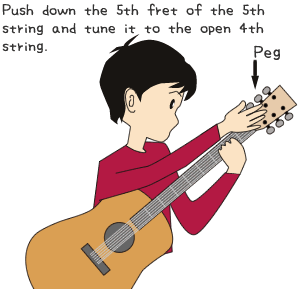- HOME
- Ono Sokki's Patio
- Beat of sound

Beat of sound
Ken: When you tune a guitar, you adjust the peg of a
string until the two strings stop making beats. Why do beats
occur? 
Dad: Oh, the tuning of a guitar. They don't adjust the sound like that since they use a tuner nowadays. Beats are from the interference of sounds with slightly different frequencies, and the difference in frequency is the characteristic of a fluctuation frequency.
Ken: Difference in frequency becomes fluctuation frequency, what does that mean?
Dad: Look at this diagram (Flash). Wave A is 200 Hz and wave B is 205 Hz. Let's listen to these two sounds first.
Ken: If you concentrate, you can tell there is a difference in pitch.
Dad: Yes. Let's try combining these two sounds. When you combine waves A and B, it becomes wave C.
Ken: When you combine the two waves, this is what it looks like. Difference becomes fluctuation frequency?
Dad: Listen to the sound first.
Ken: You can clearly hear the beats.
Dad: Yes. That sound fluctuates 5 times in 1 second. That means fluctuation frequency is 5 Hz, which is the difference of the frequencies of two sounds.
Ken: But why?
Dad: Diagram 2 is an enlarged graph of this part. Look at wave A and B where the amplitude of the combined wave is at 0.
Ken: The wave A is at the maximum on the plus side, and the wave B is at the minimum on the minus side. Since the value of plus and minus is the same, it cancels each other and becomes 0?
Dad: Yes. And as this occurs cyclically, so beats are made.
Ken: Why does it occur cyclically?
Dad: Difference between 200 Hz and 205 Hz is 5 Hz, and the ratio of 5 Hz to 200 Hz is 40. So it becomes like this graph every 40 waves, and the amplification of the added waves is plus-minus 0.
Ken: EI see. It reminds me of the fluctuating sound you taught me when we talked about the "Nakiryu".
Dad: Yes. It is a related subject. I will explain another time about a phenomenon that occurs in a condition when the frequencies of two sounds are apart.
- © ONO SOKKI CO., LTD. 1996-2025
